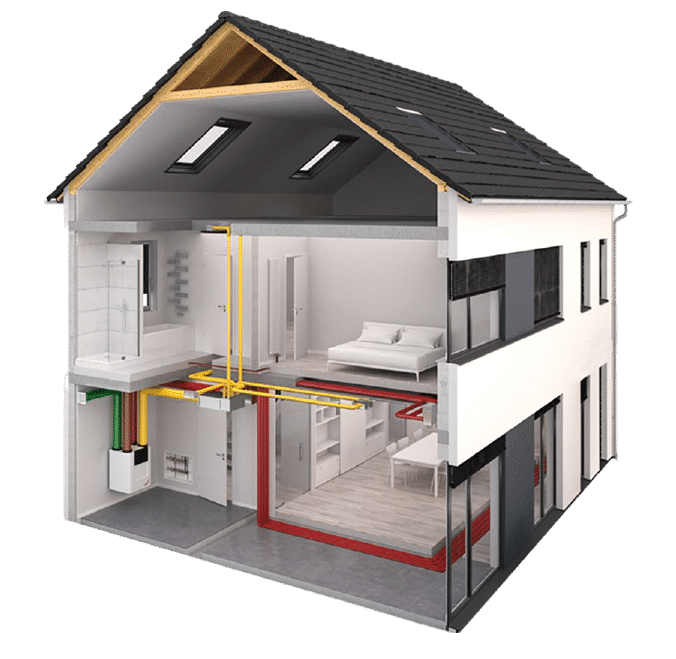The Eco-Friendly Benefits of HRV in Modern Homes
Wiki Article
The All-Inclusive Guide to the Uses of Heat Recovery Ventilation in Modern Buildings
Heat Recovery Ventilation (HRV) systems represent a considerable improvement in building modern technology (HRV Heat Recovery Ventilation). They offer an approach for exchanging stale interior air with fresh exterior air while reducing power loss. This method not only improves indoor air high quality but likewise adds to energy performance in both property and industrial buildings. Recognizing the different applications and advantages of HRV can expose its important function in modern-day design and sustainability efforts. The implications of this modern technology deserve checking out betterComprehending Heat Recovery Ventilation Systems

Although numerous modern buildings focus on energy efficiency, comprehending warm recovery ventilation (HRV) systems is vital for optimizing interior air high quality and minimizing power consumption. HRV systems work by transferring warmth from stagnant interior air to incoming fresh air, successfully keeping comfy indoor temperature levels while minimizing power loss. These systems include a warmth exchanger, fans, and ductwork that assist in the blood circulation of air. Throughout winter season, HRV devices catch and reuse warm from the outgoing air, while in summer, they can aid cool down inbound air. By constantly trading air, HRV systems additionally lower moisture and the focus of interior pollutants. Proper installation and upkeep of HRV systems are essential for their effectiveness and performance in boosting overall building performance and convenience.
Advantages of Heat Recovery Ventilation
Heat recovery ventilation systems offer numerous advantages that improve both energy efficiency and indoor air quality in contemporary structures. By recording and recycling power from exhaust air, these systems significantly reduce home heating and cooling prices, resulting in reduced power intake. They maintain a consistent circulation of fresh outside air, decreasing the danger of indoor air toxins and allergens. This continual exchange aids regulate humidity degrees, stopping mold and mildew growth and guaranteeing a much healthier living atmosphere. Additionally, HRV systems add to sustainability objectives by reducing total carbon footprints. Their capability to enhance ventilation without sacrificing thermal comfort makes them a beneficial addition to modern structure layout, promoting both economic and ecological advantages.Applications of HRV in Residential Structures
As house owners significantly prioritize energy performance and interior air high quality, the applications of heat recuperation air flow (HRV) systems in property structures have actually become a lot more widespread. HRV systems are specifically advantageous in firmly sealed homes, where keeping fresh air circulation is essential for avoiding wetness accumulation and interior contaminants. They properly transfer heat from outward bound stagnant air to incoming fresh air, decreasing energy expenses linked with cooling and heating. Additionally, HRVs can improve convenience degrees by managing moisture and temperature level. They are also adaptable for numerous property designs, including single-family homes and multi-unit structures. Overall, incorporating HRV systems sustains sustainable living techniques while guaranteeing a healthier indoor environment for owners.HRV in Business and Commercial Settings
In business and commercial settings, the execution of heat recuperation air flow (HRV) systems has become significantly important for optimizing power performance and maintaining air high quality. These systems successfully transfer heat from exhaust air to incoming fresh air, decreasing the need for extra heating or air conditioning. This not only decreases energy expenses yet also contributes to sustainability initiatives. Industries such as manufacturing, warehousing, and office complex benefit greatly from HRV systems, as they help control temperature level and moisture levels, ensuring a comfy and productive environment. In addition, HRV systems help in removing contaminants and excess wetness, enhancing interior air top quality. As policies around air top quality become stricter, the fostering of HRV innovation is most likely to grow, making it an essential component of modern-day commercial and industrial framework.Future Trends in Heat Recovery Ventilation Technology

Often Asked Inquiries
How Does Heat Recovery Ventilation Influence Indoor Air High Quality?
Heat recovery ventilation substantially boosts indoor air quality by continuously trading stagnant interior air with fresh exterior air while recouping energy. This process reduces contaminants, keeps optimal moisture degrees, and assures a healthier setting for residents.Can HRV Solutions Be Mounted in Existing Structures?
HRV systems can undoubtedly be set up in existing structures. Retrofitting may require alterations to ductwork and ventilation designs, yet it significantly boosts power effectiveness and indoor air high quality, making it a sensible choice for older structures.What Maintenance Is Needed for HRV Systems?

Exist Particular Climates Where HRV Is Much More Reliable?
Heat recovery ventilation systems are specifically efficient in climates with considerable temperature distinctions between seasons. These systems maximize energy effectiveness by recovering warmth from exhaust air, making them excellent for both cold and moderately warm atmospheres.Just How Do HRV Equipments Affect Power Expenses?

Report this wiki page